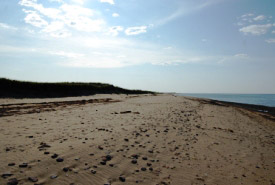Cap-Lumière

Richibucto Dunes, New Brunswick (Photo by NCC)
The Nature Conservancy of Canada (NCC) launched conservation efforts near the Richibuchto Dunes in 2009, where it has purchased more than 40 hectares for permanent conservation.
Containing salt marsh, sand dunes and a sandy beach, the Richibucto Dunes protects an important breeding beach for the nationally endangered piping plover.
The Cap Lumière Nature Reserve, was identified by NCC’s rigorous science planning process as an important coastal area to protect.
The Richibucto Dunes are situated in Kent County, New Brunswick, on the shores of the Northumberland Strait just off Cap-Lumière. The New Brunswick Northumberland Strait Natural Area extends from Point Escuminac to Cape Tormentine.
The dunes at a glance
The estuaries, coastal bogs and islands found along the coast and the shallow warm waters of the strait provide habitat for a rich diversity of species.
Some of the most ecologically significant coastal habitats in the Maritimes are found along these shores.
Salt marshes and estuaries are crucial here for waterfowl and shorebirds, while the dune systems support nesting colonies of common and Arctic terns. The area also provides habitat for nationally endangered piping plovers and beach pinweed, a vascular plant endemic to the area.
The area's dunes stretch over seven kilometres of coastline, along the Northumberland Strait.
Conservation values
The site is especially noteworthy for the broad salt marsh-peatland transition zone, which feature a high diversity of wetland communities — including calcareous wetlands.
Many New Brunswick bogs have been lost to peat harvesting. The stabilized dunes are also of significance and help rare species and community types such as beach pinweed, marram grass and dwarf-shrubland.
Other notable and provincially uncommon species found at Cap Lumière include:
- sand heather (which is almost totally restricted to our largest and most stable dune systems in New Brunswick)
- arrow grass
- seashore saltgrass
- American sea-blite
- bastard toadflax
- button-bush dodder
Partners in conservation
Many partners came together to help secure Cap Lumière. The Nature Conservancy of Canada wishes to acknowledge the Eastern Habitat Joint Venture, Modern Enterprises Limited, the Province of New Brunswick and the U.S. Fish & Wildlife Service. The Government of Canada’s Natural Areas Conservation Program was also a major contributor to this project





